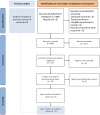A systematic review and meta-analysis of liver venous deprivation versus portal vein embolization before hepatectomy: future liver volume, postoperative outcomes, and oncological safety
- PMID: 38269320
- PMCID: PMC10806199
- DOI: 10.3389/fmed.2023.1334661
A systematic review and meta-analysis of liver venous deprivation versus portal vein embolization before hepatectomy: future liver volume, postoperative outcomes, and oncological safety
Abstract
Introduction: This systematic review aimed to compare liver venous deprivation (LVD) with portal vein embolization (PVE) in terms of future liver volume, postoperative outcomes, and oncological safety before major hepatectomy.
Methods: We conducted this systematic review and meta-analysis following the PRISMA guidelines 2020 and AMSTAR 2 guidelines. Comparative articles published before November 2022 were retained.
Results: The literature search identified nine eligible comparative studies. They included 557 patients, 207 in the LVD group and 350 in the PVE group. This systematic review and meta-analysis concluded that LVD was associated with higher future liver remnant (FLR) volume after embolization, percentage of FLR hypertrophy, lower failure of resection due to low FLR, faster kinetic growth, higher day 5 prothrombin time, and higher 3 years' disease-free survival. This study did not find any difference between the LVD and PVE groups in terms of complications related to embolization, FLR percentage of hypertrophy after embolization, failure of resection, 3-month mortality, overall morbidity, major complications, operative time, blood loss, bile leak, ascites, post hepatectomy liver failure, day 5 bilirubin level, hospital stay, and three years' overall survival.
Conclusion: LVD is as feasible and safe as PVE with encouraging results making some selected patients more suitable for surgery, even with a small FLR.
Systematic review registration: The review protocol was registered in PROSPERO before conducting the study (CRD42021287628).
Keywords: hepatectomy; liver failure; liver venous deprivation; portal embolization; remnant liver volume; surgery.
Copyright © 2024 Chaouch, Mazzotta, da Costa, Hussain, Gouader, Krimi, Panaro, Guiu, Soubrane and Oweira.
Conflict of interest statement
The authors declare that the research was conducted in the absence of any commercial or financial relationships that could be construed as a potential conflict of interest.
Figures
References
Publication types
LinkOut - more resources
Full Text Sources


